When we gaze up at the night sky, away from the bright lights of the city, we are greeted by a multitude of shimmering stars. Every person in the northern hemisphere, on a dark night without the presence of the moon, can easily locate the Big Dipper constellation among them. In this constellation, the star Mizar shines brightly at the center of the handle of the celestial “bucket”. However, upon closer inspection, one can also spot another star faintly visible next to it.

Overview
Mizar and Alcor are the most well-known binary stars visible to the naked eye, located in the handle of the Big Dipper. Mizar is derived from the Arabic word for “belt” or “girdle”, while Alcor comes from the Persian term for “unnoticed” or “forgotten”. The separation between Mizar and Alcor is approximately 1.17 light years.
When observed through a telescope, Mizar appears as a double star system composed of Mizar A and Mizar B, with a distance of 380 astronomical units between them. The duality of this celestial object in the constellation of the Big Dipper was first identified in 1650.
This finding marked the commencement of the investigation into stars of this variety. Mizar was the inaugural binary star to be captured on film in the annals of astronomy. This event took place in 1857. The individual behind the photograph was George Phillips Bond (1825 – 1865), an American astronomer.
Unearthing of Alcor and fresh exploration
Mizar’s companion was detected in 1617 by Benedetto Castelli (1578 – 1643), an Italian mathematician and disciple of the renowned scientist Galileo Galilei (1564 – 1642). Since that juncture, Mizar and its counterpart Alcor have been granted the recognized classification of a binary celestial body in astronomical science.
Thanks to advanced technology, a team of astronomers led by Erik Mamajek have been able to make a new discovery. Using powerful spectroscopes, they were able to measure the velocity of Mizar and Alcor with great precision. The results of these measurements indicated a gravitational connection between these two closely linked stars. This has led to the hypothesis that these stars form a sixfold stellar system. Such structures are extremely rare in the observable universe. Currently, scientists have only found two such objects within a radius of 130 light years from the Sun – Castor in the Gemini constellation and Mizar and Alcor in the handle of the Big Dipper.
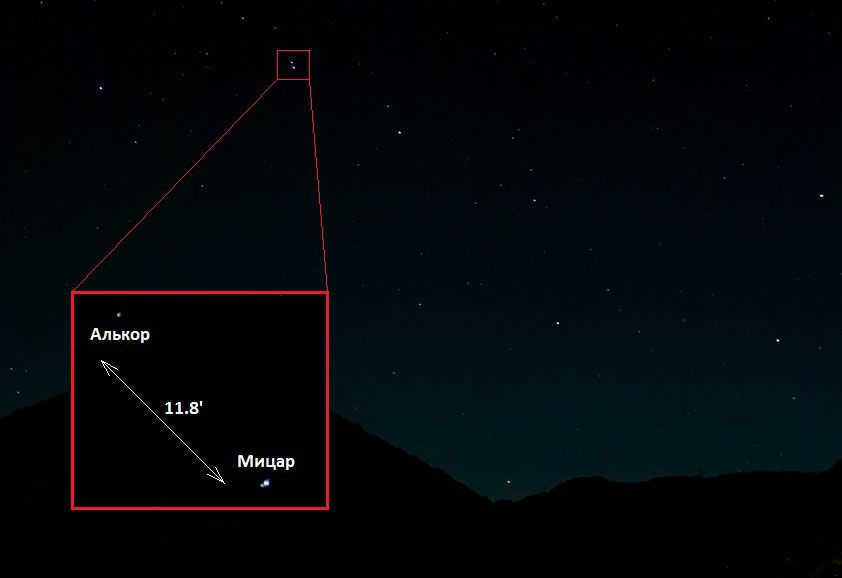
Diagram illustrating the relationship between the stars
In actuality, Mizar and its companion are binary stars. This implies that Mizar is a quadruple star. Mizar A, Mizar B, and Alcor, which are binary stars, make up a six-component star system.
They are located 70 to 83 light-years away from Earth. Mizar is a structure with a solitary center of gravity, celestial bodies orbit around it very slowly, and it takes an average of 67 Earth years for one complete revolution.
Unique Physical Characteristics of Mizar and Alcor
Distinctive physical attributes of the binary celestial luminaries and their exact coordinates within the constellation of the Big Dipper:
Observing the Stars in the Night Sky
Due to its prominence among both professional astronomers and amateur stargazers, the luminous pair can be easily discerned in the nighttime skies of the northern hemisphere throughout the year, provided clear weather conditions. By closely examining the second star in the handle of the dipper, even the unaided eye can perceive the presence of two radiant points – Mizar, the larger star, and the slightly more remote Alcor.
Curious details
Mizar is composed of 3 celestial entities, with the third sidekick star being so minuscule that it remains imperceptible even through a telescope. In 1889, the astronomer William Henry Pickering (1858 – 1938), while scrutinizing the spectrum and chemical makeup of Mizar, made a noteworthy observation that numerous dark lines discernible in the luminary’s spectrum were twinned.
Interestingly, the separation and intensity of these spectra enable astrophysicists to ascertain the trajectory of space objects, calculate stellar magnitude, and determine other physical properties of celestial luminaries. The pairing of the spectra is a result of the coexistence of 2 distinct entities, each of which is brighter than our Sun. These entities rotate at a much higher speed, completing an orbit in just 21 days.
After the discovery of the second star, Mizar B, astronomers quickly realized that Mizar was actually a binary star system. More recently, another star, Mizar D, was found, which orbits Mizar every 3.5 years. Surprisingly, Mizar’s companion, Alcor, also turned out to be a binary star system. Thanks to advanced spectroscopes, scientists were able to study the stars in close proximity to Mizar, revealing the presence of Alcor’s neighboring stars.
Mizar (Zeta of the Big Dipper) and Alcor (80 of the Big Dipper) form a binary system within the constellation of the Big Dipper. These stars are located in the handle of the Big Dipper asterism. They are blue dwarf stars in the main sequence, with a weak orbital relationship and a distance of 1 light-year between them. Mizar is a four-star system, while Alcor consists of six stars.
The pair of stars known as Mizar and Alcor is located 86 light-years away and has been historically referred to as the “Horse and Rider” due to their use in testing eyesight. Here is some information about Mizar and Alcor, which are part of the Big Dipper constellation:
Key Details
- Constellation: Big Dipper
- Coordinates: 13h 23m 55.5s (right ascension), +54° 55′ 31″ (declination)
- Distance: 86 light-years
- Stellar Types: Mizar (A2V + A2V + A1V), Alcor (A5V)
- Mass: Mizar (Aa + Bb) 2.43 solar masses, Alcor 1.8 solar masses
- Diameter: Mizar (Aa + Bb) 4.8 solar diameters, Alcor 1.76 solar diameters
- Apparent Magnitude: Mizar +2.27, Alcor +3.99
- Luminosity: Mizar (Aa + Bb) 33.3 solar luminosities, Alcor 13.4 solar luminosities
- Surface Temperature: Mizar (Aa + Bb) 9000 K, Alcor 8000 K
Perceptibility

The circumpolar nature of the Big Bucket Asterism allows residents of the northern hemisphere to enjoy its stellar display all year round. Keep your eyes peeled for the star system positioned at the handle’s center, right where the bend occurs.
The stars Mizar and Alcor, located in the Big Dipper constellation, are separated by a distance of 1.1 light-years. Mizar is made up of two stellar objects, Aa and Ab, which are separated by a distance of 0.29 astronomical units. These objects have an orbital period of rotation of 20.454 days. Mizar also has two other stellar components, Ba and Bb, which are distant from each other by 3.12 astronomical units and have a rotation period of 57 years. The Alcor star system consists of a blue dwarf, A, and a red dwarf, B, which are located 0.5-1.5 light-years apart. Both Mizar and Alcor are part of the Moving Group of stars in the Big Dipper, which means they share a common motion. However, there is currently no confirmation of a gravitational connection between them.
Background
The term “mi’zar” is derived from Arabic and can be translated as “apron, wrapper, cover, or covering”. Meanwhile, the star Alcor is derived from the word “suha” and carries the meaning of “forgotten”. According to certain Japanese legends, Alcor is referred to as the “star of life”. It was believed that individuals who were unable to locate this star in the nighttime sky would meet their demise before the year’s end.
Within the Big Dipper constellation, specifically within the handle of the Big Dipper, lies the most renowned double star in the celestial sphere – Mizar and Alcor. This duo holds a significant position not only within astronomical folklore but also throughout the entire history of astrophysics.
The status of the well-known binary star, Mizar and Alcor, has been a subject of discussion for a considerable amount of time. It is likely that you have observed this pair, as it can be found in the constellation of Ursa Major. Mizar is situated as the second star in the handle of the Big Dipper, located at its curvature. Alcor, on the other hand, is the faint companion of Mizar, which, when observed without a telescope, appears to be in close proximity to this star, with an angular separation just below half the apparent size of the Moon.
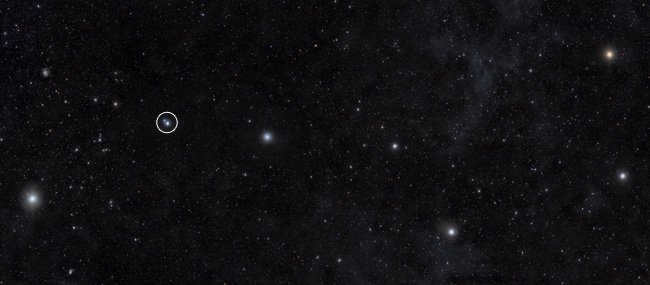
Mizar and Alcor (encircled) form a twin star system located at the bend in the handle of the Big Dipper. Image Credit: Rogelio Bernal Andreo/APOD
The question at hand was: are Mizar and Alcor an optical pair or a physical pair? If Mizar and Alcor are in close proximity to one another, then they are inevitably bound together by mutual gravitational forces, similar to how the Sun is bound to the planets of our solar system. These binary stars are referred to as physical pairs. On the other hand, if they are situated at a significant distance from each other and just happen to appear close in the sky, then we would label this pair as an optical pair.
Mizar and Alcor in ancient times
Undoubtedly, Mizar and Alcor have been familiar to humans since ancient times. It is believed to be one of the earliest observed and recognized double stars in the night sky by our distant ancestors.
During that era, the true nature of stars was not a topic of serious contemplation for most individuals. The prevailing belief was that the Earth served as the center of the Universe, with various celestial bodies such as the Moon, the Sun, planets, and, of course, stars rotating around it. One key distinction between stars and other celestial objects was that stars exhibited no apparent change in their positions in the sky – the constellations maintained their patterns for centuries. They were commonly referred to as “fixed stars.” It was widely held that the stars were affixed to the celestial sphere and represented openings in the heavens through which divine light emanated.
During that time, the knowledge of the sky had a purely practical purpose. The moon and the sun were used for timekeeping and calendaring, while the stars were a valuable tool for sailors, traders, and Bedouins in the desert to navigate and avoid getting lost.
Mizar and Alcor were used in different nations to test the sharpness and sensitivity of vision. According to legend, the Persian army used it as one of the tests to select elite warriors, and the nomads of the Middle East would test the eyesight of young men using these stars. The Arabic proverb “sees Alcor but does not notice the Moon” was used to describe someone who only pays attention to small things and doesn’t understand important matters.
While the ancient practice of the “Arab Eye Test” has been widely recognized for centuries, some modern astronomers are now questioning whether the Mizar-Alcor pair was actually used as the test. They argue that it is not necessary to have exceptionally sharp eyesight to distinguish these two stars in a clear desert sky. Sir Patrick Moore even speculated that a different, fainter star near Mitzar may have been used instead of Alcor. However, ophthalmologists argue that Alcor is dim enough to correspond to the smallest letters in the well-known Snellen test.
The names of these stars have also been passed down through the centuries. In popular astronomy books, Mizar and Alcor are often translated as “Horse” and “Rider”. However, this translation only appeared in Johann Bayer’s famous celestial atlas Uranometria (1603) as Latin names for these stars, rather than as a direct translation.
What is the meaning of Mizar and Alcor? About a millennium ago, Mizar had the name Mirak (or Merak) among the Arabs, just like the epsilon and beta stars of the Big Dipper. In the past, there was often confusion regarding which stars should bear this name, and the Arabs came up with an alternative name for Mitzar: Anak al Banat (Maiden’s Neck). The star acquired the name Mitzar approximately 400 years ago, when it was suddenly given that name by Scaliger. In Arabic, Mizar translates to Belt or Kushak. Even though this peculiar name was introduced without any apparent reason, it has gained popularity.
Alcor, Mizar’s partner, may have derived its name from the brightest star in the Big Dipper, Aliot. There is a possibility that it is a variant of the word “al-jain” (pointer). According to some scholars, the Arabs were more inclined to refer to this star as Sukha, meaning Insignificant or Faint.
If you happen to possess a telescope, make sure to gaze through it at Mizar and Alcor: when combined with their neighboring stars, they create one of the most stunning celestial objects in the heavens! Even a small device will suffice; simply peer through it at the lowest magnification setting.
The hue of these stars is diamond white, or, as Allen, the renowned researcher of celestial names, described it, “light emerald.” The angular separation between Mitzar and Alcor measures 708.55″ or 11.8′. Within the same field of view as Mitzar and Alcor, you’ll discover several other stars that enhance the scene, seemingly casting a shadow on the brilliant duo. Of particular interest is a 7th magnitude star nestled between them, known as the “Ludwig’s Star,” named after an 18th-century German astronomer. It is not associated with the Mizar and Alcor system and serves as a prime example of an optical satellite!
Now let’s examine it more closely! The brilliant star Mitsar, when observed through a telescope, can be seen as two stars that are very close to each other! It appears that in addition to Alcor, Mizar has another companion, making the double star actually a triple star!
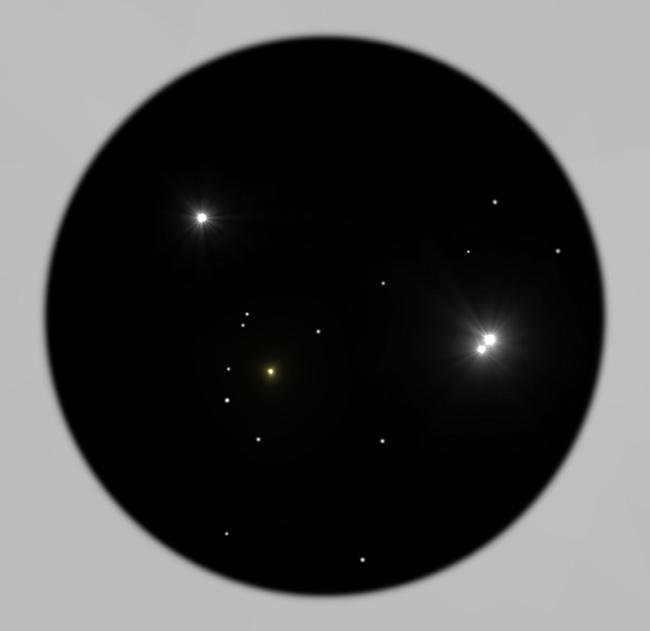
An amateur illustration of the Mizar – Alcor duo, captured using a 16-inch telescope at 260× magnification. Mizar (on the right) consists of two closely positioned white stars. Alcor can be seen on the left side of the image. Positioned between these stars is a yellow star known as Sidus Ludoviciana or Ludwig’s star, which was named by Professor Johann Liebknecht in honor of his mentor, Ludwig V, Landgrave of Hesse-Darmstadt. Although Ludwig’s star appears yellow in this sketch, it actually belongs to the bluish-white spectral class A. Along with fainter stars, it serves as an optical companion to Mizar and Alcor. Source: Iain P./CloudyNights.com
The separation between the stars Mizar A and Mizar B measures 14.4″; the primary star shines with a magnitude of 2.27m, while its companion, a similarly white star, shines with a magnitude of 3.95m. The brightness of the companion is nearly equal to that of Alcor (4.01m).
It is often mistakenly stated that the companion of Mizar was initially observed by Riccioli in 1650, but in reality, the dual nature of the star was discovered by Benedetto Castelli, a mathematician who was a friend and student of Galileo, on January 7, 1617. Castelli mentioned this discovery in one of his letters to the esteemed scientist. By January 15, 1617, both Mizar A and Mizar B had already been observed by Galileo himself.
Thus, Mizar and Alcor make their debut in the field of science as an important double star.
It is common knowledge that Galileo Galilei is recognized as the first person to observe the sky through a telescope. This event took place in 1609, during a time when the scientific community was engaged in a fierce debate regarding the structure of the Universe. Ptolemy’s geocentric model, which was based on the ancient teachings of Aristotle, proposed that the Earth was at the center of the Universe, with all other celestial bodies, including the Sun, Moon, planets, and stars, orbiting around it. This theory was highly logical for its time, as the celestial bodies do indeed appear to revolve around us, completing a full rotation in a day! (The movement of the Sun, Moon, and planets is more complex, as they also exhibit motion against the backdrop of the stars, but Ptolemy’s theory accounted for this as well.)
The Copernican system was a revolutionary departure from the Ptolemaic model of the world. It challenged the prevailing belief that the Earth was at the center and instead positioned the Sun as the central figure, relegating the Earth to the status of a mere planet. While this may seem like common knowledge now, it was a groundbreaking concept that completely transformed our understanding of the universe four centuries ago.
Galileo was an ardent advocate of the Copernican system, and his observations through the telescope only served to validate this. The initial discoveries made by Galileo using his diminutive instrument were astounding. It transpired that the Milky Way was a vast conglomerate of exceedingly faint stars, the planets possessed disks akin to that of the Sun and the Moon, and Venus and Mercury exhibited phases of illumination analogous to those of the Moon. Jupiter was encircled by satellites, almost as if exemplifying the Copernican solar system on a smaller scale… At that particular time, all of this appeared so incredulous that numerous scientists and enlightened individuals literally rejected it. It is documented that Galileo organized a public viewing of Jupiter’s satellites, during which individuals peering through the telescope claimed to be unable to perceive any satellites!
Despite this, it appeared that the telescope would have an immediate impact, shattering the traditional view of the world and providing support for the theories of Copernicus, Galileo, Giordano Bruno….
However, this was not the case! Many of Galileo’s contemporaries were unwilling to accept Copernicus’ theory, as they believed it was less consistent with observed facts than Ptolemy’s theory! Even the discoveries made with the telescope, which supported the ideas of the Polish scientist, were not enough evidence. Copernicus’ opponents continued to defend the Ptolemaic model (with some variations) – and surprisingly, these scientists also used a telescope to support their own views!
How far are the stars from us?
Galileo’s belief was that the stars were distant suns, indicating that the universe’s size was incredibly vast. However, is it feasible to determine the distances to the stars?
By employing the method of triangulation, individuals have acquired the ability to ascertain the distance to remote objects. The concept behind it is simple. First, observe this text with your left eye, and then with your right eye. Has the text shifted? This occurs because we are viewing it from different points in space. By knowing the distance between our eyes (the base) and the angle by which the text is shifted, we can calculate its distance without the use of a ruler.
Similarly, we have the capability to determine the distance to any object, even those that are incredibly far away – the only requirement is that we have a wide enough baseline so that the object’s shift in angle can be detected when viewed from its furthest points.
Can this method be utilized to measure the distance to stars? If we assume that Ptolemy is correct and that the Earth is stationary, then the answer is no. To be more specific, one could attempt to use various geographical locations on Earth’s surface as a baseline, but the results from these observations demonstrated that the stars were too distant for this baseline to be adequate in measuring their angular displacements.
However, if Copernicus was correct, there existed a tremendous opportunity to utilize the Earth’s orbit around the Sun as a reference point for measuring celestial bodies. In a span of six months, the Earth completes half a revolution around the Sun, ultimately arriving at the opposite end of its orbit. By observing the position of a star at intervals of six months, as proposed by Copernicus, it would be possible to detect its slight displacement in the sky (referred to as the parallax by astronomers) and ultimately determine the star’s distance.
Copernicus recognized this implication of his theory and attempted to employ the parallaxes of stars as one of the primary evidences supporting his correctness. However, the parallaxes proved too minuscule to be discerned with the naked eye. Neither Copernicus nor the renowned Tycho Braga were able to detect them.
Perhaps a telescope would provide assistance in this matter.
Galileo’s argument went like this. If stars are distant suns and they all have similar brightness, then it is reasonable to assume that the dimmer the star, the farther away it is.. If we take two stars, one bright and one dim, we can assume that the bright star will have a greater parallax than the dim star. Therefore, we should choose a pair of stars with different brightness that are close together and measure the distance between them every six months. This method is easier than measuring the displacements of each star separately. (Galileo got these ideas from Ludovico Ramponi. Ludovico Ramponi..)
The most suitable pair of stars for this purpose were Mizar and Alcor.
Galileo’s curiosity was piqued by this concept, leading him to create a unique telescope hood with a distinct cutout specifically designed for these three stars. The survival of his detailed drawing of this special lens indicates his strong interest in accurately measuring the angle.

Castelli’s observation (on the left) displays Mizar (A), Alcor (B), and the star Ludovico (C). Galileo’s diagram (on the right) illustrates Galileo’s triangular arrangement for Mizar’s parallax experiments. Reference: Siebert, JHA 2005
That was when Castelli made an important finding: he discovered that Mizar itself was comprised of two stars, with the second star having a similar brightness to Alcor. The distance between the two stars was much smaller compared to the distance between Alcor and Mitsar. A more suitable pair for measuring parallax could not have been devised!
Castelli, Galileo, and other scientists of that era made multiple attempts to detect the displacement of Mizar A in relation to Mizar B, but each attempt was unsuccessful. Galileo was disappointed to discover that the stars were much farther away from Earth than he had initially believed. This failure allowed his opponents to claim victory, as no parallaxes were observed, thus discrediting Copernicus’ theory!
Today, we now understand that the parallaxes of stars are incredibly small and beyond the observational accuracy of that time. Furthermore, both Galileo and other astronomers assumed that the duality of Mizar was optical, but it is not. Mizar A and Mizar B are actually a physical pair that are close together, resulting in the same parallaxes.
And now we come back to the matter of binary stars. It appears that four centuries ago, very few individuals would have entertained the notion that two closely situated stars in the celestial sphere could be physically linked to one another. As you may observe, the prevailing assumption was that all binary stars in the night sky (of which there were a handful known) were merely optical. It was only following the identification of numerous telescopic binaries, subsequent to Newton’s formulation of his renowned laws of mechanics, that the perspective began to undergo a transformation.
The astronomers of that time were also interested in the size of stars. By using the naked eye or a telescope to measure the disks of stars and comparing them to the visible disk of the Sun, they hoped to determine the distance between the stars and the Earth.
Astronomers were able to “see” and measure the disks of stars, including the size of the brightest star in the sky, Sirius. According to Tycho Brahe, Sirius had a diameter that was 0.61 times the diameter of the Earth. Alcor, on the other hand, was used as a reference for a faint star and had a diameter of only 0.15 times the diameter of our planet, as determined by Brahe.
Later, Riccioli replicated the same experiment but used a telescope for assistance. Through the telescope, he observed that the “disks” of stars, unlike planets, did not appear to increase in size but were still visible. By using Alcor as an example, Riccioli demonstrated that if one were to calculate the distance to the stars based on Copernicus’ theory, their size would become extraordinarily large – even larger than the Earth’s orbit. This concept seemed completely implausible at the time. Riccioli effectively utilized this argument to discredit Copernicus and his supporters.
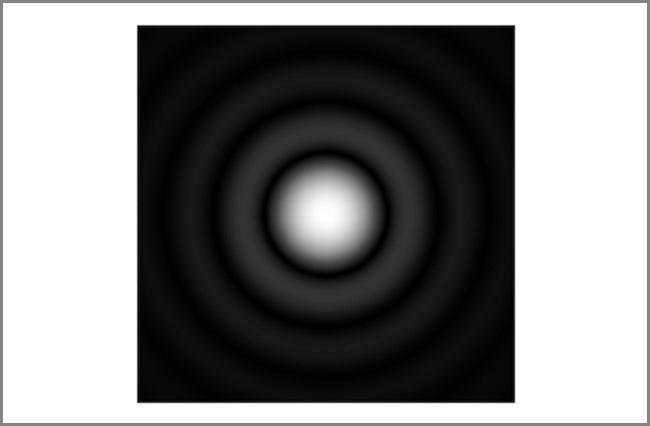
The apparent disk of a star that astronomers in the past believed they were seeing was actually Airy’s circle, a diffraction disk that indicates the limit of a telescope’s resolution. Source:photographylife.com
It is important to note that stars cannot actually be observed as disks through a telescope. What astronomers were actually observing was the scattering of the star’s bright light on the retina. By using a hood to remove excess light, the star would appear as a nearly point-like dot. However, when using high magnifications, astronomers were able to see disks surrounded by rings. These disks are known as Airy disks and are formed as a result of light diffraction, unrelated to the actual disks of stars.
Mizar excels in every aspect

Over time, astronomers became aware of the immense size of the universe. William Herschel, a renowned astronomer of the 18th century who discovered Uranus and conducted extensive research on nebulae, dedicated several decades to studying double stars. He made the remarkable discovery and detailed descriptions of hundreds of double stars, some of which exhibited orbital motion! As the 19th century commenced, there was no longer any uncertainty that at least certain double and multiple stars were physically interconnected.
Additionally, the parallaxes of stars were uncovered, enabling astronomers to determine the distance to the nearest stars. It was revealed that even the closest stars were significantly more distant than what Galileo’s astronomers had ever envisioned.
Mizar and Alcor are positioned approximately 80 light-years away from Earth. Photo: DSS2
However, what about Mizar and Alcor? It seems that they are both moving in a similar direction through space, along with four other prominent stars in the Big Dipper. Evidently, the Big Dipper served as the central hub for a nearby dispersed star cluster, with its members scattered across the celestial sphere.
Nevertheless, it remained unclear whether this pair constituted a physical binary system or simply belonged to the same star cluster. Astronomers managed to determine the distance to Mizar and Alcor, which turned out to be approximately 80 light-years away. Taking into account that the stars appear separated by nearly 12 arc minutes in the sky, astronomers calculated that the actual distance between the stars is in fact tens of thousands of astronomical units! (1 a.u. is equivalent to the average distance between the Earth and the Sun, i.e. approximately 150 million kilometers.)
Stars at such a tremendous distance can only be held together by gravity if their mass is large enough. Until about a century ago, astronomers believed that the combined mass of the stars in this system was insufficient to maintain their orbital motion. However, over time, intriguing details began to emerge.
As mentioned earlier, Mizar and Alcor were seemingly the first pair of stars to be identified in the sky. Furthermore, Mizar was the initial double star to be observed through a telescope. Yet, the list of Mizar’s accomplishments does not stop there!
In 1857, Mizar became the first double star to be captured in a photograph. This daguerreotype was obtained at the Harvard Observatory by Bond, Jr. (Seven years prior, Bond Sr. had photographed Vega, the initial star in the night sky, at the same observatory!)
In 1890, the discovery of Mizar marked a significant milestone in astronomy as it was the first spectral double star ever found. Through careful observation of the absorption lines in the spectrum of Mizar A, astronomer Pickering deduced that it is comprised of two stars orbiting around a common center of mass with a remarkably short period of only 104 days! (This period was later refined to 20 days.) This revelation transformed Mizar into a triple star, and if the two stars were physically connected, the Mizar-Alcor system would become a quadruple star system!
The proximity of the stars in the Mizar A system is so close that they cannot be distinguished by any telescope. However, interferometry techniques enabled astronomers to separate them. In 1925, Mizar A became one of the pioneering double stars to have the distance between its components measured interferometrically.
What is the final result? Mizar presents itself to us as a constellation of four stars! Two pairs can be observed individually – Mizar A and Mizar B are visible, as we have previously observed, even with a basic telescope, but separating the pair into distinct components is only possible using astrophysical techniques.
And once again, the question arises: if the Mizar – Alcor system is not composed of two stars, but instead five, then perhaps the combined mass of the components is sufficient to establish a gravitational connection between Mizar and Alcor?
Mizar and Alcor form a six-star system
The resolution to this discussion appears to have been reached in 2010, when a group of astronomers led by Eric Mamajec (Eric Mamajec) made a fascinating discovery… a companion to the star Alcor! Alcor B was revealed to be a typical red dwarf, positioned just 1 arc second away from its host star. It is so faint that it is overshadowed by Alcor’s brightness. In order to locate it, we had to utilize the infrared camera of the 6.5-meter telescope, MMT, located in Arizona and equipped with adaptive optics.
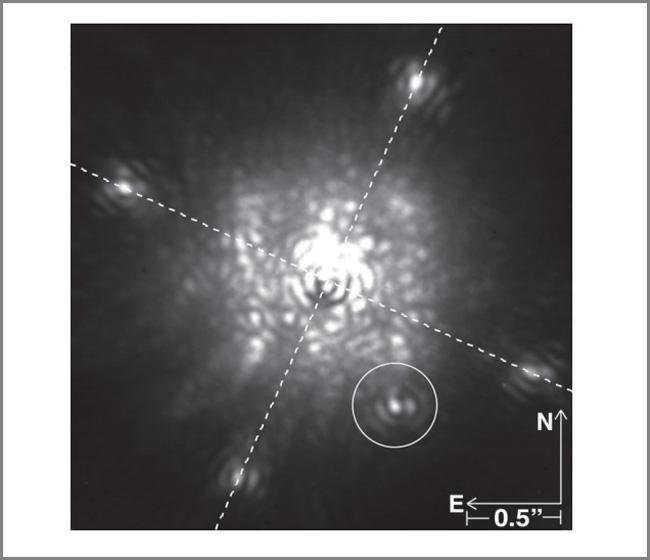
The star Alcor and its companion (circled) were captured in this infrared image. The brightness of Alcor is diminished by the protective hood. Reference: Neil Zimmerman et al, 2010
This astonishing revelation has increased the mass of Alcor by 0.3 solar masses, equivalent to the mass of Alcor B. Consequently, the total mass of the Mizar-Alcor system now stands at 9 solar masses! Precise measurements of the velocities and trajectories of both celestial bodies indicate that Alcor and Mizar are likely gravitationally bound, resulting in a sixfold stellar system! a sixfold star system.
Star systems like these are extremely rare. There are believed to be only two such stars within 130 light-years of the sun. Castor in the Gemini constellation and Mizar with Alcor. This is what makes the star in the handle of the Big Dipper so amazing!
Mizar and Alcor in figures
Constellation: Ursa Major
Visible stellar magnitude: 2.23 + 4.01
Spectral Class: A1Vp + A5V
Parallax ("): 0.03801 for Mizar and 0.03991 for Alcor
Distance: 25 pc.
Coordinates α (2000): 13h 23min 55.5s
Coordinates δ (2000): +54° 55′ 31″
Proper motion α: 0.120″/yr.
Proper motion δ: -0.016″/yr
Age: 500 million years
The Mizar – Alcor system
| Mizar A | 2.27 | 73 | A1Vp | 9000 | 2.5 | ||
| Mizar B | 4.00 | 15 | A1Vp | 9000 | 2.5 | 20.5377 days. | |
| Mizar C | 3.95 | 15 | A7m | 7500 | 1.94 | ~5000 years around Mizar A | 14.4″ from the Mizar A + B pair |
| Mizar D | ? | M | 0.25 | 175.55 days. | |||
| Alcor A | 4.01 | 13 | A5V | 8030 | 1.8 | millions of years around Mizar | 708.55″ from Mitsar, 74±39 thousand a.e. |
| Alcor B | ~12 | 0.03 | M3V | 3300 | 0.3 | 1.11″ from Alcor A |
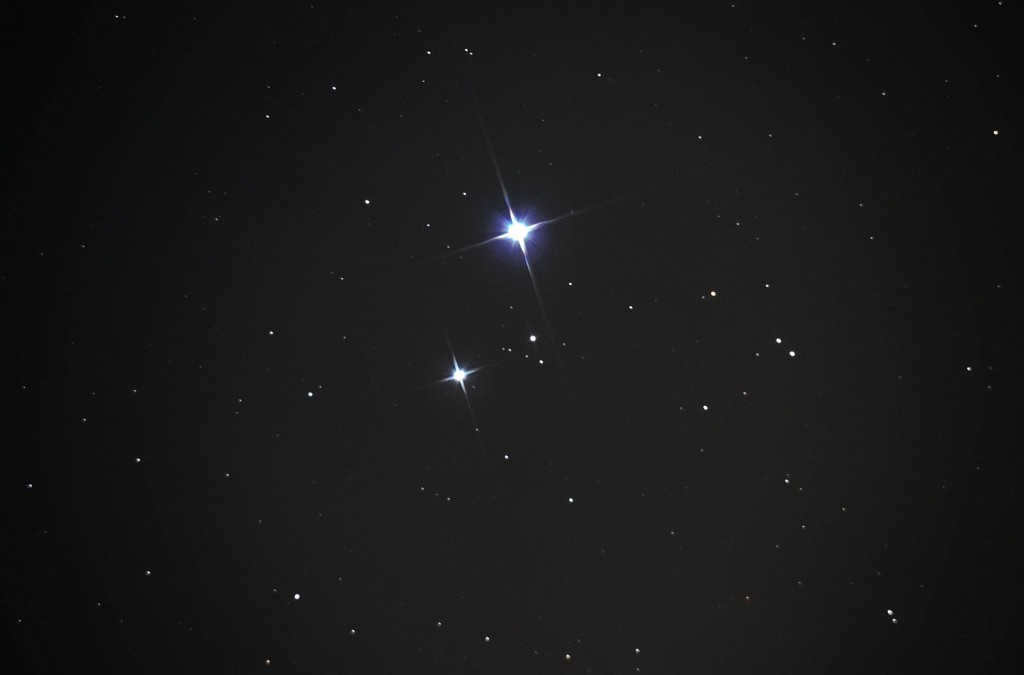
According to the legends of Arabia, the noble Mitzar and Alcor represent a horse and its rider in physical form. It is said that only those with exceptionally keen eyesight can spot Alcor in the night sky.
General details
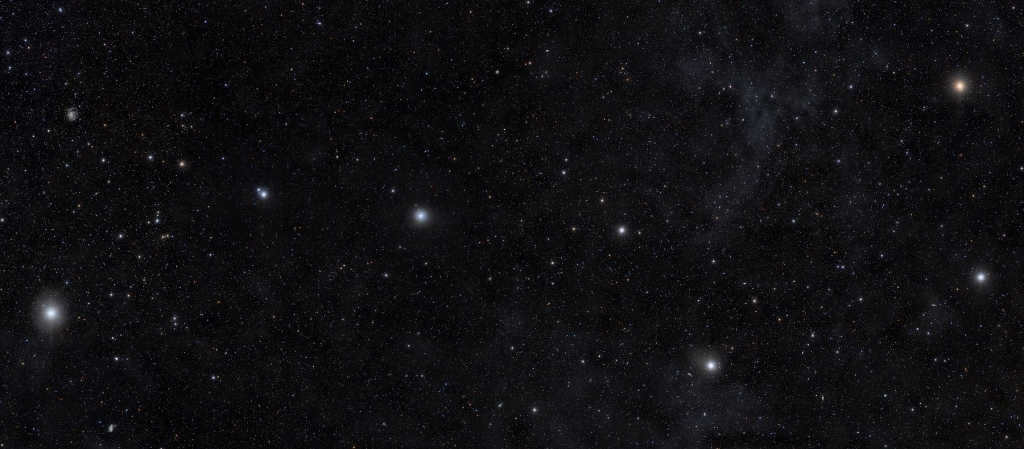
The second star from the handle of the “bucket” in the Big Dipper constellation is known as Mizar and Alcor.
The Big Dipper, also known as the Bucket, is the most well-known constellation in the Northern Hemisphere. It consists of a group of seven stars that can be seen in the night sky. One of the stars, Mizar, is located on the handle of the bucket. If you take a closer look, you will notice another faint star next to it, which is its companion, Alcor. Together, Mizar and Alcor form a double star system. However, it is important to note that not all objects that appear close to each other in the sky are physically connected. In many cases, it is just an optical illusion.
With a magnitude of 2.4 and belonging to the same spectral class A, the star Mizar shines brighter and has a higher temperature (subclass 1). Its companion, Alcor, has a magnitude of 4.02 and is relatively cooler (subclass 5).
Illustration showcasing the connection between the stars

This system is recognized as the inaugural binary star in the annals of astronomy. A short time later, employing a telescope, J. Riccioli observed that Mizar itself is comprised of two celestial entities, designated as A and B. This sequence of divisions into components did not cease there. In the early 20th century, it became apparent that each component, in turn, is a binary star. Spectroscopic studies revealed consistent deviations in spectral lines. Through straightforward arithmetic calculations, it was determined that the resulting aggregate system is composed of five parts.
Due to its considerable distance from the Mizar cluster, not all astronomers concurred in regarding Alcor as a bona fide component of the structure, citing discrepancies in their interaction and motion.
In the vastness of space, objects are spread out over a distance of 12 angular minutes, which is equivalent to more than a quarter of a light year. To put it into perspective, this distance is 17 thousand times greater than the distance between the Sun and the Earth.
Unveiling the Companion of Alcor
It wasn’t until 2009 that a team of researchers at the University of Rochester, led by E. Mamajek, made a fascinating discovery while analyzing images. They found that Alcor is actually a binary star system, consisting of two stars.

In order to achieve this, they had to utilize a specialized program to process individual photographs, eliminating the glare from the primary star that was overshadowing the red dwarf. The fact that the red dwarf is so minuscule in size, with a weight that is only a third of our own Sun, allowed it to remain hidden for such a significant period of time. The existence of Alcor B explains the discrepancies in the star’s motion, which previously prevented the recognition of a gravitational connection between Mizar and Alcor. As the scientists delved deeper into their research, they were able to calculate the direction and velocity of the components that make up the double star. During the same period, an independent group of researchers also confirmed the presence of two components within the Alcor system, thus validating the findings of the astronomers from Rochester.
Continued Research
The ongoing investigation into the Alcor star system has led to a significant discovery. It has been found that the system contains a sixth component, which helps explain the presence of X-ray radiation. This type of radiation is typically not associated with white stars, but is a common phenomenon for red dwarfs. The Alcor system is now the second known multiple system in close proximity to our Sun, with Castor being the first. E. Mamazek, a renowned scientist, is dedicated to further studying Alcor, as there are still many unanswered questions surrounding this intriguing star.

The constellation of the Big Dipper
Actually, the star names do not translate from Arabic as “rider” and “horse”. Mizar means “cushak” and Alcor means “forgotten”.
In numerous cultures, there are stories about the utilization of Alcor to assess the vision quality of future warriors. In ancient Egypt, it was used in the personal troops of the pharaoh, while in the Arab, Greek, and Roman civilizations, it was used by archers. In Japan, an individual who couldn’t differentiate between neighboring Mitsara was considered old, indicating that it was time to prepare for death.
However, contrary to what the ancients claimed, seeing Alcor is not as difficult as they thought, and it doesn’t require exceptional eyesight. Can you spot the rider on Mitzar?
Did you enjoy this article? Share it with your friends!
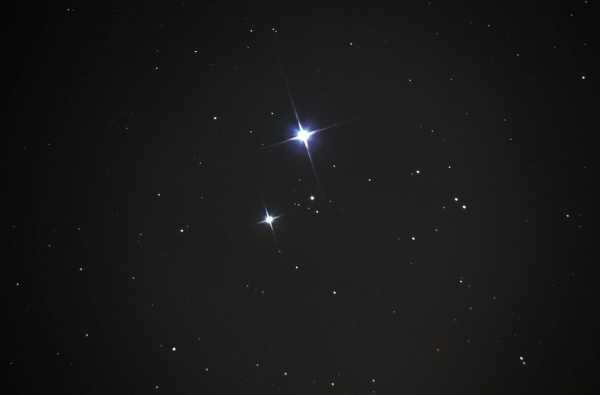
As per the legends of Arabia, the majestic Mitzar and Alkor represent the horse and its rider, and it takes a person with exceptionally keen eyesight to spot the latter in the celestial expanse.
Basic details
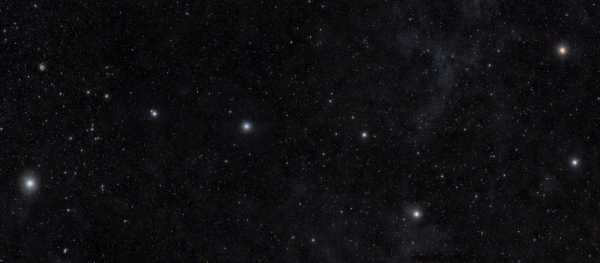
Mizar and Alcor are the second star from the handle of the “bucket” in the constellation known as the Big Dipper.
The Big Dipper, also known as the Bucket, is the most well-known constellation in the Northern Hemisphere. It consists of seven stars that form a distinct shape in the night sky. Mizar is located at the penultimate point on the handle of the bucket. Upon closer inspection, you can see a faint star nearby, which is its constant companion, Alcor. Together, they create a double star system. However, it is important to note that not all objects that appear close to each other are physically connected. In many cases, it is simply an optical illusion.
Schematic representation of the interconnectedness among the celestial bodies
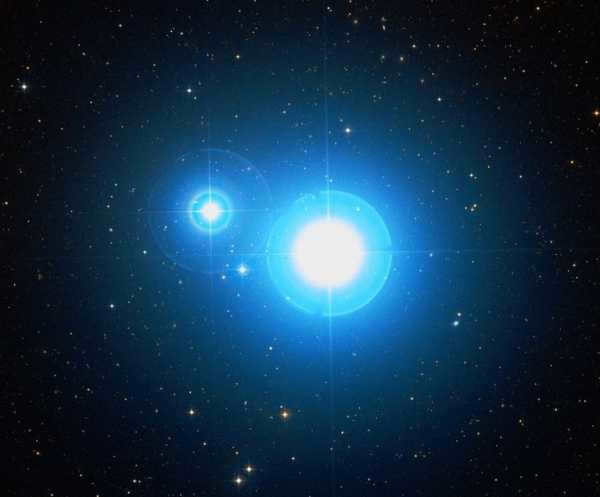
This particular system has been acclaimed as the inaugural binary star in the annals of astronomy. A bit later on, utilizing a telescope, J. Riccioli discovered that Mizar itself is comprised of two celestial entities, A and B. This sequence of divisions into constituents did not cease there. At the dawn of the 20th century, it became apparent that each individual component is, in fact, a binary star. Investigations conducted through spectroscopic means revealed consistent deviations in the lines. Simple calculations revealed that the overall system is composed of 5 distinct parts.
Due to the considerable spatial separation from the Mitzar cluster, not all astronomers concurred when it came to considering Alcor as a fully-fledged constituent of the structure, citing discrepancies in their interaction and motion.
In the vast expanse of space, celestial objects are distributed across vast distances, with a separation of 12 angular minutes or over a quarter of a light year. To put this into perspective, it is equivalent to a staggering 17 thousand times the distance between the Sun and the Earth.
The Unveiling of Alcor’s Companion
It was not until 2009 that a team of researchers from the University of Rochester, under the leadership of E. Mamajek, made a remarkable discovery while examining images. They found that Alcor, already known as a star, is actually part of a binary system, making it a double star.

In order to achieve this, they had to utilize a specialized software that eliminates the glare coming from the main star, which overshadows the red dwarf. The red dwarf’s tiny size, weighing only one third of our Sun, allowed it to remain concealed for such a significant period of time. The presence of Alcor B elucidates the discrepancies observed in the star’s motion, which hindered the recognition of the gravitational connection between Mitsar and Alcor. In their ongoing research, scientists were able to calculate the direction and velocity of the double stars’ components. Simultaneously, an independent team of researchers discovered the existence of two components within the Alcor system, thus corroborating the findings of the Rochester astronomers.
The identification of the sixth element in the system clarified the presence of X-ray emissions, which are atypical for white stars but common for red dwarfs. This particular multiple system is now the second one discovered in close proximity to the Sun, following Castor. E. Mamazek remains dedicated to investigating Alcor, as there are still unresolved enigmas surrounding this celestial body.
Fascinating information






